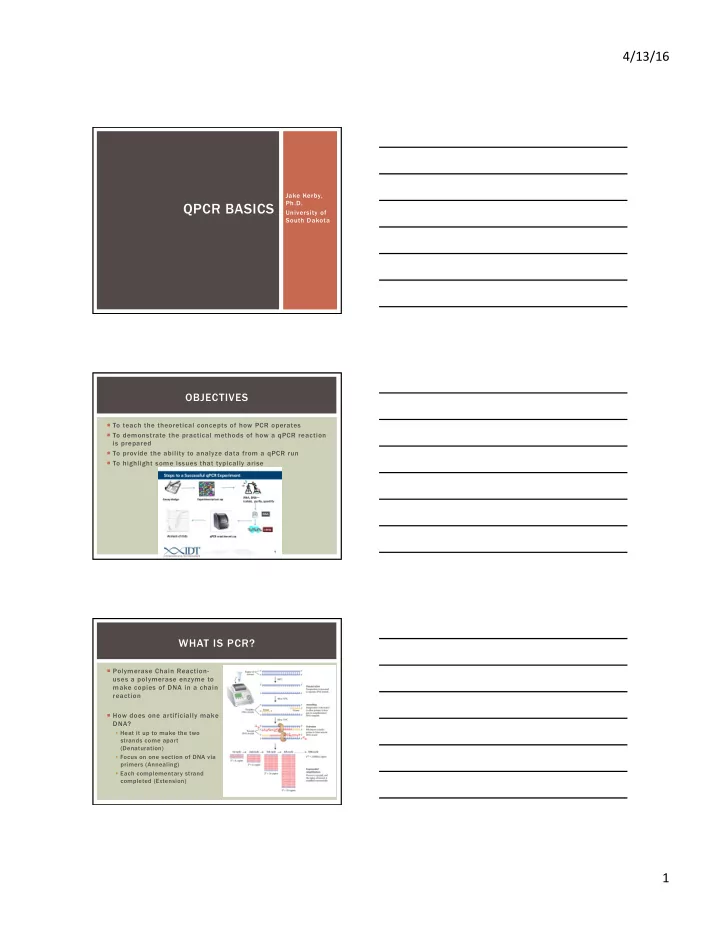

4/13/16 ¡ Jake Kerby, Ph.D. QPCR BASICS University of South Dakota OBJECTIVES ¡ To teach the theoretical concepts of how PCR operates ¡ To demonstrate the practical methods of how a qPCR reaction is prepared ¡ To provide the ability to analyze data from a qPCR run ¡ To highlight some issues that typically arise WHAT IS PCR? ¡ Polymerase Chain Reaction- uses a polymerase enzyme to make copies of DNA in a chain reaction ¡ How does one artificially make DNA? § Heat it up to make the two strands come apart (Denaturation) § Focus on one section of DNA via primers (Annealing) § Each complementary strand completed (Extension) 1 ¡
4/13/16 ¡ HOW DOES IT WORK? ¡ PCR Reaction ¡ Temperature Profile § DNA, Primers § Stages of the reaction § Temperature § Number of cycles § Taq Polymerase § dNTP § Mg 2+ DETECTION ¡ Gel Electrophoresis § Use charged liquid to pull DNA through a gel media § Include a known sample of size standards (ladder) § Can compare your replication with the ladder to determine if it worked! ¡ Limitations § Difficult to quantify § Difficult to determine presence/absence § Is a slight band a positive? ¡ Advantages § Cheap!!!!!! WHAT IS QPCR? ¡ Quantitative PCR (or Real time PCR) § It provides an estimate of your product § It provides this estimate after every single cycle 2 ¡
4/13/16 ¡ HOW DOES IT WORK? ¡ The PCR part works exactly the same! ¡ Two methods § Cyber Green (Non-specific) § Taqman (Targeted- like primers) ¡ Both use a fluorescent dye method. § As the product increases in concentration, more dye is able to fluoresce. § Machine measures this fluorescence value TAQMAN APPROACH ¡ Reporter Dyes: FAM, TET, JOE, VIC, Texas Red ¡ Quencher: TAMRA, MGB, Black Hole ¡ Reference: ROX PRIMER CHOICE ¡ Conserved Ranavirus region ¡ Other sequences more specific to type: FV3, ATV, ENHV ¡ FAM, VIC, NED § Fluoresce at different wavelengths § Allow multiple targets to be examined § Could be used to identify different strains of RV 3 ¡
4/13/16 ¡ MULTIPLEX ¡ Run simultaneous tests on one sample ¡ Use reporters that fluoresce at different wavelengths STANDARD CURVE ¡ Measurement of fluorescence is relative (Ct values) ¡ To create a comparison we must add in known quantities § Similar to the ladder in PCR. § Here we add in known quantities rather than known sizes. STANDARDS ¡ Plaque forming units- estimate of virus quantity § Requires the isolation, culturing, and counting of virus ¡ Gene copies § Order section of sequence from molecular company § Can verify DNA quantity § IDT- gBlocks 4 ¡
4/13/16 ¡ RANAVIRUS PROTOCOL ¡ TaqMan ¡ Primers § Forward: ACACCACCGCCCAAAAGTAC § Reverse: CCGTTCATGATGCGGATAATG ¡ Probe § CCTCATCGTTCTGGCCATCAACCAC ¡ Heat cycle (40 cycles) 95°C 10 min (activate taq) ¡ 1) 95° 20s (denature) ¡ 2) 54° 20s (anneal) ¡ 3) 72° 30s (elongation) RANAVIRUS PROTOCOL ¡ Reaction volumes per well 4.6 ul Water 10 ul 2x TaqMan Mastermix 0.6 ul Forward Primer (300 nmol) 1.8 ul Reverse Primer (900 nmol) 1 ul Probe (250 nmol) 2 ul DNA Template (~ 100ng) ____ 20 ul RANAVIRUS PROTOCOL ¡ Alternate protocol 2x TaqMan Mastermix Forward Primer (300 nmol) Reverse Primer (300 nmol) Probe (200 nmol) DNA Template (~ 100ng) 5 ¡
4/13/16 ¡ CONTROLS ¡ Negative controls § Water § Sample tissue ¡ Positive controls § Infected animal § Virus culture § DNA ¡ Important to guard against both contamination and inhibition REPLICATION ¡ Often each sample (and standard) is run in triplicate § Ensures confidence in negative results and positive values ¡ Some laboratories use less (duplicate or singlicate) § Cheaper § Higher sample size can make up for error ANALYSIS ¡ Machine will attempt to score the samples for you based upon your standard curve. ¡ How do I know if it worked? ¡ What if some of my standards are bad? ¡ What if my samples have a range of values? 6 ¡
4/13/16 ¡ OUTPUT CHANGING THE THRESHOLD MESSY DATA 7 ¡
4/13/16 ¡ QUESTIONS? ¡ Email me at: Jacob.Kerby@usd.edu 8 ¡
Recommend
More recommend